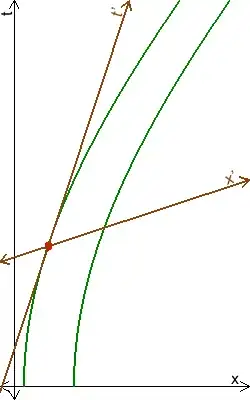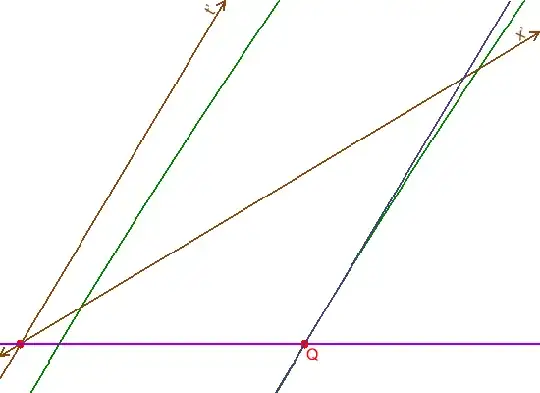Joshua, there is no paradox here.
For a start, notice that the paradox is based on contradictory assumptions. In the link you provide it says:
The distance between the spaceships does not undergo Lorentz contraction with respect to the distance at the start, because in S it is effectively defined to remain the same, due to the equal and simultaneous acceleration of both spaceships in S.
If the acceleration of both spaceships is equal and simultaneous in the frame in which they are moving (and providing we are allowed to use SR for accelerated movement), than at any (period of) time any pair of points located in this frame of reference must undergo exactly the same movement, and therefore the same change of distance between them as demanded bu Lorentz Transforms. See my answer on SE where the concept of space contraction in SR is illustrated.
So if both ends of Spaceship A undergo the same acceleration $a$, and if both ends of Spaceship B undergo the same acceleration $a$, than also the points at both ends of the rope (denoting the distance between the ships) undergo the same acceleration $a$. Therefore, if Spaceship A is contracted, and Spaceship B is contracted, then also the distance between them must be contracted. So if accelerations are equal and simultaneous than the distance between the ships cannot remain constant. (despite what the experiment assumes)
On the other hand, if the distance between the spaceships is to remain constant, than the accelerations of the spaceships must not be equal and simultaneous in the frame in which they are moving, if one wants to claim SR holds true for this movement. (again, despite what the experiment assumes)
One cannot postulate that all the points in a frame undergo the same movement at any given time, and yet distances between them change contrary to the conditions set for this movement.
Also, the entry Special Relativity in Wikipedia still reads:
In physics, special relativity (SR, also known as the special theory of relativity or STR) is the accepted physical theory regarding the relationship between space and time. It is based on two postulates: (1) that the laws of physics are invariant (i.e., identical) in all inertial systems (non-accelerating frames of reference); and (2) ...
So, despite what you might find in the very formulation of this paradox, as well as in other answers and comments to your question, the postulate of non-accelerated relative motion in SR is still upheld by mainstream physics. And this site is supposed to stick to mainstream physics.
Should you be curious, however, how the acceleration was introduced to SR: Well it was sneaked in illegally through a non-physical trick:
The proponents say there exist "momentarily co-moving" inertial frames of reference (see Alfred Centauri's answer), which means that time is supposed to stop "momentarily" which makes the accelerated motion non-accelerated. Well, these mathematicians forget that in physics once you stop time, you also stop all motion (movement is defined as a change in position, and you cannot change position in no time, because this would imply infinite velocity, which is forbidden by the very SR), which means you cannot apply any transforms to the situation at all. Tricks are for kids ...
Additional proof that above is cheating in order SR to illegally sneak in acceleration. I followed the link Alfred Centauri provided in his answer, and there we have: "Also, d˛x/dt˛ = 1 at t = 0. [Translation: Initial acceleration is 1.]." So no time has passed (Δt=0) and yet a ship acquired a non-zero acceleration?! But in his answer wrote: "...imagine another inertial reference frame with relative speed v in which the rope is momentarily at rest". "Momentarily" means Δt=0 again, and yet this time we have inertial frame. And this "momentarily inertial frame" was necessary to claim that accelerations are allowed in SR.
So when they need acceleration, they can have it at Δt=0, but when they need an inertial frame they get it from the same Δt=0 as well? Now, are we still talking physics here?
John Rennie here on SE also contradicts it. He says that the very space is contracted at relativistic speeds. In the answer to the question: "How long would it take me to travel to a distant star?", he said: "If the spaceship is travelling at velocity v relative to the Earth and destination star then the Earth and star are travelling at velocity v relative to the spaceship, and the crew of the spaceship see distances contracted by the Lorentz factor". If distances are contracted then Bell's spaceships do not retain the same distance d as seen by stationary observer.
You can use a more straightforward logic, though.
Lorentz Transforms show distance contraction between any two points moving at relativistic speed. The equation does not care if the points belong to a single body or two. If you wield the spaceships together using a metal rod, you can claim this is just one spaceship (always measured to move at $v$ throughout the whole length: SpaceshipA+String+SpaceshipB). By the same logic you could say the spaceships should break, because there is space inside them which does not undergo contraction, and so the chassis of the spaceship will be stretched. Should someone say the space is within the spaceship, and so it moves, I will ask, what if the design of the spaceship demands there are areas of outer space allowed within the spaceship construction? Will the chassis brake then?
And the last - and final - blow. Due to the very axioms of SR the spaceships connected by a rope can always be treated as stationary, and everything else moving at relativistic speeds. Therefore, the spaceships do not even have to accelerate to be seen as moving at relativistic speed from some other frame (itself accelerated to relativistic speed). So, should we assume the string will brake only because someone claims he sees the distance $d$ between the ships unchanged? Absurd!
(In his comment below Ján Lalinský said that we are dealing with accelerations here, which disproves my argument above. Well, SR is based on the axiom that there are no preferred frames of reference. Assuming that acceleration forbids me from treating the spaceships' frame of reference as stationary means also that preferred frames do exist in SR. Which is contrary to the axioms of the very theory we are basing our reasoning here.
Still, even if accelerations were admitted in SR, one would have to prove that in such case distance between moving points should change differently than it does in its classical version - without accelerations - and not contract.)
The logic of SR demands that the distance between any two relativistically moving points be contracted. Therefore this is a manufactured paradox. Shame it is still upheld by Wikipedia and top universities.



